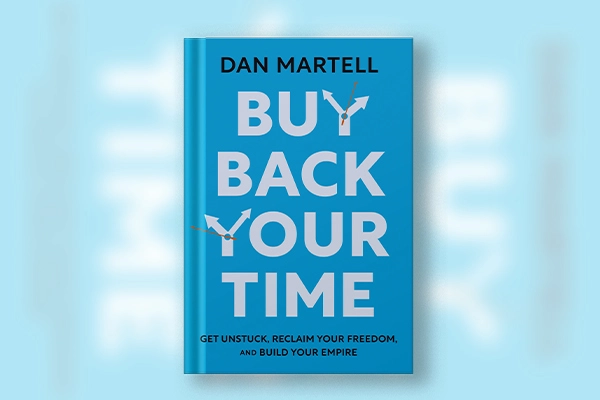Buy Back Your Time

You launched a business to gain freedom, but now you’re trapped by it. You find yourself dreading work, knowing you have a mountain of emails, a new set of fires to put out, and a line of clients and employees waiting to dump problems on your lap. You come home exhausted, stressed, and still thinking about everything left undone.
The common advice is to just work harder, but that “GSD (Get Shit Done) mentality” is a trap that leads to burnout, not a breakthrough. It’s a path many entrepreneurs follow, only to find their success stalled and their personal lives tanking.
But what if there’s a better way? The lessons come from a man who went from leading police on a high-speed chase and landing in jail to building a software empire. His name is Dan Martell, and his book, Buy Back Your Time, offers a powerful framework for escaping this cycle. This post distills the five most impactful and surprising takeaways from his philosophy—lessons that can fundamentally change how you run your business and your life.
Hire to Buy Back Your Time, Not Just to Grow Your Business
The first and most fundamental mindset shift is the “Buyback Principle.” It’s a simple but profound reframe of why you should hire people.
Conventional wisdom dictates that you hire only when your business is growing and you need more capacity to handle the workload. Martell argues this is backward. The primary reason to hire someone is not to grow your business, but to buy back your own time.
This reframe is powerful because it positions your time—not just your revenue—as the most critical asset to manage and reinvest. Instead of waiting for growth to justify a new hire, you use hiring as a tool to free yourself from low-value tasks, allowing you to focus on the activities that only you can do to drive real growth.
The Buyback Principle: Don’t hire to grow your business. Hire to buy back your time.
You’re Probably Sabotaging Your Own Success to Avoid Pain
Ever wonder why your business hits a plateau you can’t seem to break through? The answer might not be in the market, but in your own subconscious. Martell introduces the concept of the “Pain Line”—the point where more business growth equals more personal pain for the founder. As your calendar explodes and responsibilities mount, the business becomes a source of dread.
When entrepreneurs hit their Pain Line, they subconsciously react in one of three ways to stop the growth and, therefore, the pain:
- Sell: They get so desperate to escape the pain that they decide to sell the business at any cost, losing their passion and settling for a fraction of its potential value.
- Sabotage: They make unnecessarily dramatic decisions that knock the business back to a more manageable state. This manifests in several identifiable patterns: you might suddenly decide to launch a new, unplanned product; urgently overhaul your website; keep replacing key team players for small mistakes; or drag your feet on business decisions until the opportunity slides by.
- Stall: They make a conscious decision to stop growing, preferring a smaller, less overwhelming company. But a decision to not grow is a decision to slowly die, as your best employees leave for better opportunities and your customers leave for better options.
This is a surprising insight because it reframes business stagnation not as a market failure, but as an act of psychological self-protection. You won’t let your business grow into something more painful, even if it means ruining it.
An entrepreneur will ruin their business before letting it grow into something more painful. They may do it subconsciously, and they may do it slowly—just enough—to bring the pain of their growing company back to a manageable amount of difficulty.
Your Chaotic Past Might Be Your Biggest Weakness
Many entrepreneurs come from challenging or chaotic childhoods, which equipped them with the resilience and problem-solving skills to thrive in the uncertainty of a startup. However, this background can also create a counter-intuitive weakness: an “addiction to chaos.” When things are calm, it can feel strange, creating an inward anxiety and a need to find the next fire to put out.
This addiction manifests in what Martell calls the “5 Time Assassins”—distinct, identifiable patterns of behavior that kill your success:
- The Staller: You sabotage success by hesitating on big decisions, never saying yes or no, until the opportunity passes you by.
- The Speed Demon: You make rapid, ill-considered decisions because you prioritize speed over quality. You haphazardly hire the first candidate you find (whether it’s an aunt, a friend, or the mailman). You forcefully select the first technology platform you find. You go with the first lender available. As a result, you find yourself solving the same problems over and over.
- The Supervisor: You micromanage others or take over their tasks completely. By stepping in to “save the day,” you rob your team of the chance to learn and create a permanent dependency on you, ensuring you’re always needed for every little thing.
- The Saver: You hoard cash and refuse to reinvest it in growth opportunities that could save you time and generate massive returns, often getting stuck on a $10 decision that could unlock a $10,000 opportunity.
- The Self-Medicator: You use vices like food or alcohol to either celebrate success or escape pain, ultimately sabotaging your long-term energy, focus, and productivity.
This framework is critical because it helps you recognize your own self-defeating behaviors not as isolated mistakes, but as symptoms of a deeper, identifiable pattern rooted in your past. This internal comfort with chaos is an undeniable asset. As Silicon Valley entrepreneur Steve Blank notes, the external environment of a startup mirrors this state, which is why so many founders thrive in it.
Startups are inherently chaos. As a founder, you need to prepare yourself to think creatively and independently, because more often than not, conditions on the ground will change so rapidly that the original well-thought-out business plan becomes irrelevant. —Steve Blank
Stop Guessing and Calculate What You Can’t Afford to Do Yourself
Delegation often feels like a vague, emotional choice. How do you decide what to off-load? Martell provides a practical, mathematical tool to eliminate the guesswork: the “Buyback Rate.”
The formula is simple. First, calculate your effective hourly worth by taking your total annual income from the business and dividing it by 2,000 (a standard work year). Your Buyback Rate is that number divided by four (or 25% of your hourly worth).
For example, consider “Tina,” an entrepreneur making $200,000 per year from her business.
- Her hourly rate is 100 (200,000 / 2,000 hours).
- Her Buyback Rate is 25 (100 / 4).
This means any task Tina can outsource for less than $25 per hour is a task she is losing money on by doing it herself. The time she spends paying invoices or editing video is time she could have invested in $100-per-hour activities. This simple calculation transforms delegation from an emotional debate into a clear, data-driven financial strategy.
Aim for 80% Perfect, Because It’s 100% Awesome
One of the biggest hurdles to delegation is the belief that “no one can do it as well as I can” or “no one will care as much as you do.” This perfectionism keeps founders trapped in low-value work, acting as a bottleneck to growth.
Martell’s counter is a powerful mindset shift: stop aiming for 100% perfection. If someone else can get a task done to an 80% standard, you should transfer it immediately.
Why? Because the value proposition is overwhelmingly positive. The freedom you gain, the energy you reclaim, and the ability to focus on high-value tasks are far more valuable than the final 20% of “perfect” execution. You not having to come in on a weekend or miss your kids’ game is 100% awesome. The small difference in execution is a tiny price to pay for the massive return in time and focus.
80% done by someone else is 100% freaking awesome.
Conclusion: Start Your Buyback Loop
True business growth and personal freedom aren’t about grinding harder; they come from strategically buying back your time and reinvesting it where it generates the most value and energy. This isn’t a one-time fix but a continuous process.
To put these ideas into action, you can use the “Buyback Loop”—a simple, repeatable system:
- Audit your time to identify the low-value tasks sucking your energy.
- Transfer those tasks to someone else.
- Fill your newly freed time with higher-value activities that light you up.
By repeating this loop, you continually upgrade your time, building a business that grows in lockstep with your personal freedom.
Dan Martell is a successful entrepreneur, angel investor, and one of the most respected coaches in the software as a service (SaaS) industry. He founded, scaled, and sold three tech companies within ten years and was named Canada’s top angel investor in 2012 after investing in more than 50 startups, including Intercom, Udemy, and Unbounce. In 2016, he launched the SaaS Academy, which has since become one of the world’s largest business coaching programs. Despite a difficult youth, Martell turned his life around through computer programming and entrepreneurship. Today, he’s also an Ironman athlete, philanthropist, husband, and father of two boys.
Book details
- Title: Buy Back Your Time
- Explanatory Title: Get Unstuck, Reclaim Your Freedom, and Build Your Empire
- Author: Dan Martell
- Publisher: Portfolio
- Publication Date: January 17, 2023
- Print Length: 272 pages
- ISBN-10: 059342297X
- ISBN-13: 978-0593422977
- Category: Small Business / Entrepreneurship / Time Management

